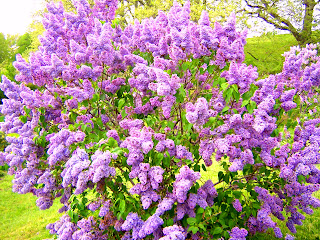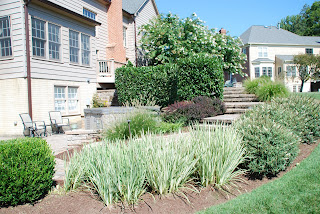Monday, April 29, 2013
Plant of the Week: Lilac
Lilacs are a very popular spring-flowering shrub because they are hardy, easy to grow, and low maintenance. Lilacs produce abundant, colorful flower clusters with a sweet, memorable fragrance. They have deep green leaves and large, oval clusters of compound blooms that come in 7 colors: deep purple, lavender, blue, red, pink, white, or creamy yellow. The fragrant flowers are good for cutting for flower arrangements and attractive to butterflies. Lilac shrubs can grow from 5 to 15 feet tall, depending on the variety so it is important to space multiple lilac shrubs 5 to 15 feet apart, depending on the variety. Also, make sure to plant them in a site where they will get full sun—at least 6 hours. If lilacs don't get enough sun, they will not bloom well.
Wednesday, April 24, 2013
Outdoor Rooms
Do you ever think of your outdoor living spaces as
“outdoor rooms?” Just as a house has “interior rooms” defined
by walls, ceilings, doors and view windows, an “outdoor room” is similarly
defined to create a comfortable and pleasurable experience.
An arbor can be used to create an entry “door” to your
space,
which could be further defined by spatial "walls created with plantings
or stone.
A pergola,
the overhead canopy of well-placed trees,
or pavilion structure can be used to create “ceilings.”
All these elements, and many others, can be professionally
designed to come together and create an outdoor room with a comfortable human scale that opens up into higher and
wider views of interest. What is the state of your outdoor rooms?
If you feel something is lacking in your “outdoor room”
experience, give us a call at Kane Landscapes, Inc.
and we would welcome the opportunity meet with you to create
a vision that excites you.
Plant of the Week: Dogwood Tree
While this March was lacking in color due to the delay in arrival of Spring, we are now seeing an abundance of color in April, especially with all of the flowering trees blooming at the same time. Normally, at this point in spring, the cherry blossoms would have shed their flowers, and dogwoods would now be at their peak.
This weeks Plant of the Week, the Flowering dogwood, is a smaller ornamental tree that typically grows to a height of 35 to 40 feet (10 to 12 m). This low-branched tree produces creamy-white flowers with 4 petals each in early spring. It is a deciduous tree, meaning it looses its leaves in the fall. Dogwoods thrive in forested, shady areas under other hardwoods and pines. If your landscape boarders a wooded area, consider the dogwood to provide year round interest and color, with the flowers in the spring, bright red/purple leaves and fruit, in the fall, and black or brown alligator-skin like bark in the winter.
This weeks Plant of the Week, the Flowering dogwood, is a smaller ornamental tree that typically grows to a height of 35 to 40 feet (10 to 12 m). This low-branched tree produces creamy-white flowers with 4 petals each in early spring. It is a deciduous tree, meaning it looses its leaves in the fall. Dogwoods thrive in forested, shady areas under other hardwoods and pines. If your landscape boarders a wooded area, consider the dogwood to provide year round interest and color, with the flowers in the spring, bright red/purple leaves and fruit, in the fall, and black or brown alligator-skin like bark in the winter.
Monday, April 22, 2013
Come Alive Outside
On April 22, 2013, Kane
Landscapes participated in the nationwide PLANET Day of Service, by bringing
volunteers to a home in Dunn Loring, VA, operated by Langley Residential
Support Services, serving adults with intellectual disabilities. In the spirit
of this year's Day of Service theme, "Come Alive Outside," we celebrated
Earth Day by making the outdoor environment for the 6 residents that live at
this home more enjoyable by constructing a patio, adding color with plants, and
re-establishing a vegetable garden.
Kane
Landscapes has a special relationship with Langley Residential Support Services,
with our President, Josh Kane, serving on the Board of Directors for the past 2 years. Josh Kane said of the event, “We wanted to donate our time and
resources to make the lives of these individuals more enjoyable by providing an
outdoor environment they can use.”
We
had a wonderful time with the residents and staff of Langley Residential. We
would like to thank all of our employees and other volunteers for your help in bringing life to their outdoor
environment. And a special thank you to Langley Residential and the residents
for making this such an enjoyable Earth Day!
 |
| BEFORE - Garden area |
 |
| BEFORE - Patio area |
 |
| Putting on our gloves |
 |
| EXCAVATION for the patio |
 |
| Plant layout around patio |
 |
| Removing the debris from garden |
 |
| Lending a helping hand |
 |
| Planting fruit, veggies, and herbs in the garden |
 |
| The finished garden |
 |
| Adding life and color around patio |
 |
| Cleaning off the patio |
 |
| The finished patio area |
 |
| Resident and Director of Langley Residential admiring patio |
 |
| Memorial bricks engraved with donors' messages |
 |
| Showing off our new shirts |
 |
| The whole crew |
Monday, April 8, 2013
Plant of the Week: Saucer Magnolia
The Saucer Magnolia is a deciduous tree with large, early-blooming flowers in various shades of white, pink, and purple. It is one of the most commonly used magnolias in horticulture. This small, low-branched tree reaches a height of 20'-25', and get's its name from the fragrant, saucer-shaped flowers. Magnolias should be planted in full sun and make for fine specimen plants, meaning they should be planted alone, rather than in masses with other plants for an ornamental effect.
Wednesday, April 3, 2013
Mo..Mo..Mo..Mowing!
It seems many people try to pick up the art of mowing, and many fail in
creating a masterpiece. Most feel this is a goof-proof chore, but the truth is
that properly mowed lawns are healthier and more beautiful. There are five key
techniques to follow when cutting the lawn:
Height, Frequency, Blade Sharpness, Clippings, and Direction/Pattern.
Height:
When servicing the lawn the height is important. The minimum height of the
blades should be 3” inches. This allows the root system to be protected from
the sun and reduces scalping or cutting into the dirt when you go over an
uneven area.
Frequency: Not
only is mowing height important, so is consistency of cuts. The
minimum requirement for most lawns is weekly cutting. Anything
less than weekly, you are harming your turf by removing too much of the grass
blade in one visit.
Blade Sharpness:
Do you think surgeons use dull blades? Neither do lawn professionals who
provide quality service. Sharp
lawnmower blades produce clean cuts, and clean cuts promote better grass
health. Dull lawnmower blades, by contrast, produce rougher cuts that make the
grass more susceptible to disease and cause the tips of the grass to turn brown
and die.
Clippings: Recycling grass clippings back into the lawn
reduces water loss, lowers soil temperatures, and returns vital nutrients to
the soil. A common misunderstanding is that mulching mowers contribute
to thatch buildup. Frequent mowing and the right equipment makes all the
difference.
Direction: Alternate the direction in which you cut the lawn each
mowing. This will help prevent your lawn from establishing ruts from the mower
wheels passing over the same area in the
same direction.
If you or your lawn service provider follows the above tips,
you will be setting a good foundation for taking your lawn to the next level in
health and appearance.
Written By: David Hensel, Maintenance Manager
Tuesday, April 2, 2013
Plant of the Week: Tulips
Tulips are one of the most popular spring flowers and come in a large variety of colors and sizes. While tulips bloom in the spring, the best time for planting the bulbs is in the fall, between October and November. While they are classified with perennials and should bloom year after year, for best results they should be treated as annuals and replanted every year. Tulips thrive in sandy, or well-drained soil and enjoy full sun.
Fun Facts about Tulips:
- Tulip ranks as the third most popular flower world-wide, behind the rose and chrysanthemum.
- There are now over 3,000 different registered varieties of cultivated Tulips.
- Tulips originated in Turkey getting their name from the Turkish word "tulbend" which means turban.
- Tulip bulbs are a great replacement for onions in cooking.
- Adding sugar to your water will help prolong the life of a bouquet of tulips in a vase.
Subscribe to:
Comments (Atom)








-ps.jpg)






